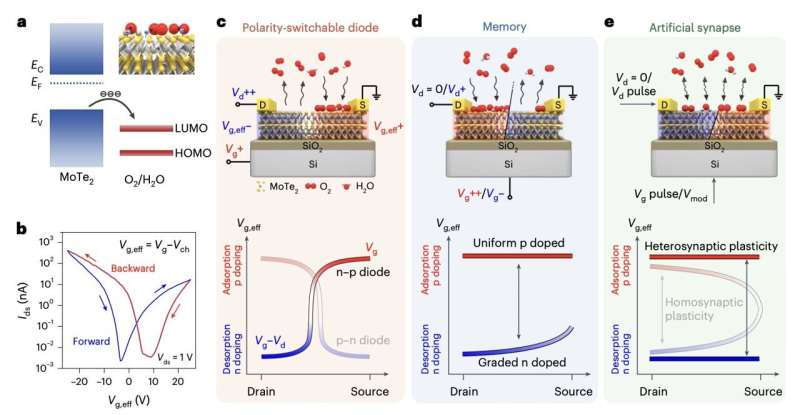Reconfigurable molybdenum ditelluride devices with multiple functions
Over the past decades, electronics engineers have been trying to develop increasingly smaller and highly performing field effect transistors (FETs) with multiple functions. FETs are crucial components of most electronics on the market today, which can control the electrical current flowing through devices.
Downscaling FETs to reach sizes below 10nm, however, has proved very challenging. Some studies have thus been exploring the potential of reconfigurable devices, devices that can change their function as they are operating, as alternatives to conventional FETs.
Many of the reconfigurable devices developed in recent years are based on silicon FETs. While some of these devices achieved encouraging results, they typically require complex electronic circuitry and additional memory units, which significantly limits their large-scale fabrication and makes them difficult to integrate with other electronic components.
Researchers at Tsinghua University recently developed new non-volatile reconfigurable devices that can switch between multiple functions, serving as diodes, memories, logic gates, and even artificial synapses in neuromorphic computing hardware. These new reconfigurable devices, introduced in a paper published in Nature Electronics, are based on the semiconductor molybdenum ditelluride, thus overcoming some of the limitations associated with their silicon-based counterparts.
“Two-dimensional semiconductors are promising materials for making non-volatile reconfigurable devices due to their atomic thinness and strong gate control, but it is challenging to create varied reconfigurable functions with a simple device configuration,” Yonghuang Wu, Bolun Wang, and their colleagues wrote in their paper. “We show that an effective-gate-voltage-programmed graded-doping strategy can be used to create a single-gate two-dimensional molybdenum ditelluride device with multiple reconfigurable functions.”
The team’s reconfigurable devices were developed using a particular doping strategy that ultimately enables their multiple functions. The researchers assessed their device in a series of tests, also comparing its performance and capabilities with those of previously developed reconfigurable devices based on 2D materials.
Their findings were highly promising, showing that the device’s reconfigurability is comparable in some cases greater than that of other designs introduced in past literature. In addition, the device was found to achieve remarkable results in all of its different functions and could be easier to upscale than silicon-based alternatives.
“The device can be programmed to function as a polarity-switchable diode, memory, in-memory Boolean logic gates and artificial synapses with homosynaptic plasticity and heterosynaptic plasticity,” Wu, Wang and their colleagues wrote. “As a diode, the device exhibits a rectification ratio of up to 104; as an artificial hetero synapse, it shows heterosynaptic metaplasticity with a modulatory power consumption that can be reduced to 7.3 fW.”
In the future, the molybdenum ditelluride-based device introduced by Wu, Wang, and their colleagues could be improved, integrated with other electronics, and assessed further in additional experiments. In addition, its design could inspire the development of other reconfigurable and multi-functional devices, opening promising research avenues for the enhancement of electronics.
More information:
Ruixuan Peng et al, Programmable graded doping for reconfigurable molybdenum ditelluride devices, Nature Electronics (2023). DOI: 10.1038/s41928-023-01056-1
© 2023 Science X Network
Citation:
Reconfigurable molybdenum ditelluride devices with multiple functions (2023, December 5)
retrieved 6 December 2023
from https://techxplore.com/news/2023-12-reconfigurable-molybdenum-ditelluride-devices-multiple.html
This document is subject to copyright. Apart from any fair dealing for the purpose of private study or research, no
part may be reproduced without the written permission. The content is provided for information purposes only.

Comments are closed